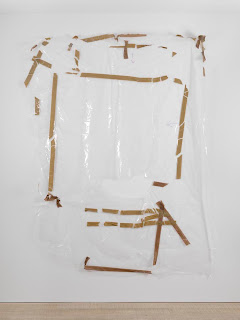I'm interested in Egan's work because she uses everyday materials that
can be found around a studio then uses them to make something else. She
also changes the form of ready made environments, using shape and scale
to create a new experience of a commonly used space.
Drawing Room - Aleana Egan
'Drawing plays a significant role in Egan’s work, with a sketchbook
providing a repository for the noting down of ideas and experimentation
with forms that undergo many changes as they are transformed into
collages, sculptures or films. Ideas are triggered through observation
of her surroundings, be it the Irish landscape or the space in which she
makes or exhibits work, and through memories of childhood experiences
and works of literature.
Her works evolve through a series of stages, with each successive layer
gaining a density until the final form emerges, coherent and cogent, yet
insistently resisting the stamp of the finite. The meandering, sensuous
line that dominates her sculptures, films and drawings suggests a
condition of flux.
Egan often works with very crude materials such as cardboard, plaster
and concrete, and her sculptures are painted with carefully mixed, matt
and muted colours of greys and blues. There is a fine tension and taut
balance in all her work regardless of material or position in space. Her
hanging hand-made sculptures made of cardboard and filler appear
utterly opposite to the hard line and tension of the steel sculptures.
Her new 4 metre high steel sculpture titled Binet’s addition, is based on Emile Zola’s novel Au Bonheur des Dames
an observation of one of the most famous department stores ‘La Bon
Marche’ of the French architect René Binet, who created the iron-framed
elevator for Parisian shops.
In a new work Outfit, Egan literally photographs her models,
mostly friends and family, from the neck down wearing a variety of
outfits. Standing with their back or front to the camera, these are
objective recordings: each figure stands motionless in the same light
and same conditions. It is the shape of the form, the colour and visual
composition that interests Egan. She does not wish to tell stories or
make grand gestures but to find appropriate forms to render
psychological states and experiences.
An artists’ book will be published by the Drawing Room to coincide with
the exhibition.
Aleana Egan was born in Dublin in 1979 and lives between Berlin and
Dublin.'
Drawing Room - Aleana Egan: In conversation with Dr Sarah Lowndes
'Drawing forms the starting point of Egan’s work, with a
sketchbook providing a repository for the noting down of ideas and
experimentation with forms that are developed into autonomous drawings,
collages, sculptures and films. Ideas are triggered through
observations made during everyday life, but also by memories of
childhood experiences and works of literature. Often inchoate, these are
atmospheric and sensory triggers that lack narrative definition and
carry through into her practice through a subtle and intuitive working
process. For example, it was the aura of tightness, a certain tension,
that reading Jean Rhy’s novel ‘Good Morning, Midnight’ left her with,
and it was this quality that she sought to engender in a sculptural form
Character, 2010, although quite different from the drawing
that Egan made after reading this story, does retain some of its
characteristics.
Her works evolve through a series of stages, with
each successive layer gaining a density until the final form emerges,
coherent and cogent, yet insistently resisting the stamp of the finite.
Her practice is dominated by a meandering, sensuous line which carries
through into the fluid way in which her films are made and suggests a
condition of flux. When the line is filled to form a plane and to
become a receptacle, it is still kept open, to collect snow or rain
water, as in, for example, In Their Order of Appearance, 2010,
made for the Sculpture Center in New York. Egan often works with very
crude materials such as cardboard, plaster and concrete, and her
sculptures are painted with carefully mixed, very matt colours. The
rawness and openness of the sentiment or idea that triggered the work is
embodied by these carefully manipulated materials. Egan does not wish
to tell stories or make grand gestures but to find appropriate forms to
engender psychological states and memories.'












































